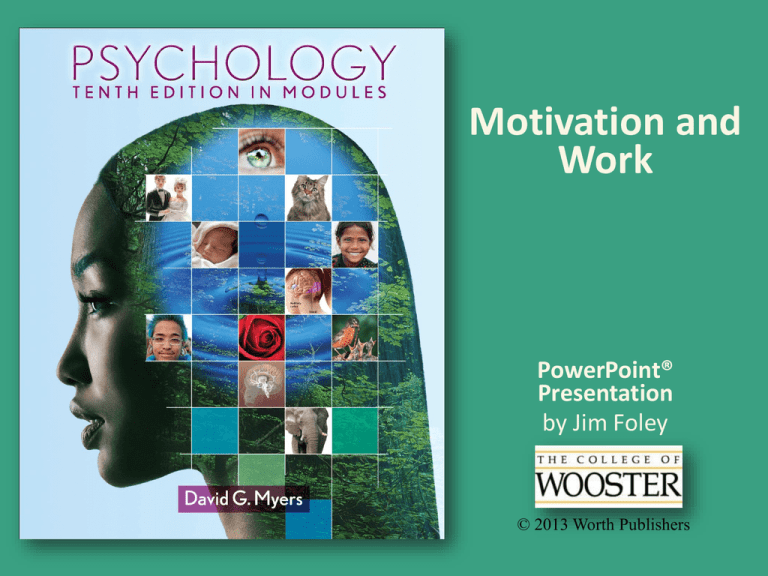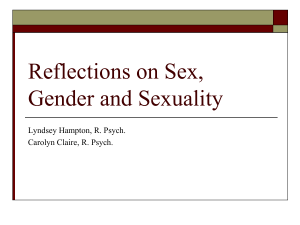
Motivation and
Work
PowerPoint®
Presentation
by Jim Foley
© 2013 Worth Publishers
Module 33: Sexual Motivation,
and the Need to Belong
Another Human Motivation: Sex
Sexual motivation may have evolved to enable creatures
to pass on their genes.
Issues to explore about sex:
physiological, including
the response cycle (with
disorders of sexual
response), hormones,
and stimuli
developmental, especially
in adolescence
sexual orientation and its
possible origins
The Sexual Response Cycle
Beginning in the late 1950s, William Masters and
Virginia Johnson observed sexual arousal and orgasm to
learn about the typical pattern of human response to
sexual stimulation. Their findings:
Phase
Excitement
Plateau
Orgasm
Resolution
Physiological Response
Genitals fill with blood and lubricate, ready for
intercourse; breathing and pulse become rapid
The changes related to excitement reach a peak
Contractions all over the body; sexual release
Enlarged genitals release blood; male goes
through refractory phase, women resolve slower
Sexual Response Disorders
Some people have a variation or impairment in some phase
of the sexual response cycle.
These variations are sometimes distressful or problematic
enough to be seen as disorders:
premature ejaculation
erectile dysfunction
low sexual desire
lack of orgasm response
These can
improve with
behavioral
therapy, other
psychotherapy,
and/or
medication.
Hormones and Sexual Motivation
Sexual desire and response is
not as tied to hormone levels in
humans as it is in animals.
During ovulation, women
show a rise in estrogen and
also in testosterone.
As this happens, sexual desire
rises in women and also in the
men around them (whose
testosterone level rises).
Low levels of testosterone can
reduce sexual motivation.
The Psychology of Sex
Like hunger, sexual desire is a function of biological factors, internal
drives, external and imagined stimuli, and cultural expectations.
The Effect of External Stimuli
All effects of external stimuli on
sexual behavior are more
common in men than in women.
The short-term effect of
exposure to images of nudity
and sexuality increases sexual
arousal and desire.
Possible dangers include:
the distortion of our ideas of
what is appropriate and
effective for mutual sexual
satisfaction.
the habit of finding sexual
response through idealized
images may lead to
decreased sexual response to
real-life sexual partners.
Imagined Stimuli
The brain is involved in
sexuality; people with no
genital sensation (e.g.
spinal cord injuries) can
feel sexual desire.
The brain also contains
dreams, memories, and
fantasies that stimulate
sexual desire.
Fantasies are not just a
replacement for sexual
activity; they often
accompany sex.
Which of the following is NOT mentioned in your
text as a factor contributing to teen pregnancy?
A. Easy access to birth control
B. Guilt related to sexual activity
C. Alcohol use
D. Media portrayal of unprotected sex
Teen Pregnancy and
Contraception
American teens have higher rates of pregnancy and
abortion than European teens. Possible reasons
include:
inadequate communication about birth control with
parents and sexual partners.
guilt about sex may make American teens less likely
to plan for it and use contraception.
alcohol use may make impulsive sex more likely and
impair decision making.
media portrayals in the United States make
unprotected sex look common and free from
consequences.
Sexually Transmitted Infections
Unlike the risk of pregnancy, the risk of STIs
multiplies and spreads, and condoms do not offer
sufficient protection for STIs like herpes.
Sex and bad math: Herb has sex with 9 people, each
of whom has 9 other partners who each have sex
with 9 people. To how many people could his STI
spread?
511
(Laura Brannon and Timothy Brock study estimate)
Factors Correlating with Sexual Restraint
Participation in
abstinence education
programs, even when
randomly assigned to
participate
Strong religious
beliefs and
involvement
High intelligence test
scores, thinking of
consequences, and
focusing on future
achievement
Presence of father in
the home
Participation in
activity helping
others, even when
randomly assigned to
participate
Sexual Orientation
Sexual orientation refers
to one’s preferences as an
object of sexual
attraction.
This attraction may not
necessarily result in sexual
activity, but may exist in
the form of desires,
interests, infatuations, and
fantasies.
“Identity” as either
heterosexual, bisexual, or
exclusively homosexual,
emerges in puberty.
Sexual Orientation
Statistics
How many people are
exclusively homosexual?
Based on a compilation of
surveys:
3 percent of men and
1-2 percent of women.
Are the surveys missing
anyone?
These surveys protected
anonymity, BUT they
defined sexual
preference as sexual
activity. Many do not
act on their preference.
Sexual Orientation
and Mental Health
Forty years ago,
homosexuality was
considered a
psychological disorder.
Having a homosexual
orientation in today’s
society still puts one at
risk for anxiety and mood
disorders because of the
stress of discrimination
and isolation, and the
difficulty in finding
satisfying and loving
relationships.
Researchers found somewhat higher
levels of homosexuality among
males who have:
A.
B.
C.
D.
older brothers.
more than one sister.
no siblings.
been raised by only their mother.
Which of the following is NOT supported
by research as a factor contributing to
homosexual orientation?
A. Prenatal hormonal exposure
B. Genetics
C. Being raised by homosexual parents
D. Having several older biological brothers
Origins of Sexual Orientation
Theories suggesting that
sexual preference is related to
parenting behaviors or
childhood abuse are not
supported by evidence.
Differences appear to begin at
birth. This could be genetic, or
it could be caused by
exposure to hormones or
antigens in the womb.
The fraternal birth order
effect: being born after a
brother increases the
likelihood of being gay.
Cause or Effect?
The brain and other
differences in sexual
orientation
Heterosexual men have a
certain cell cluster in the
hypothalamus that, on
average, is larger than in
gay men and in women.
Gay men are more likely
than straight men to be
poets, fiction writers,
artists, and musicians.
Homosexuality
• Our sexual orientation is so basic to who we
are that some research suggests it operates
automatically—without our awareness (Jiang
et al., 2006).
• The bottom line from a half-century’s theory
and research: If there are environmental
factors that influence sexual orientation, we
do not yet know what they are.
Biological and Behavioral Differences
Associated with Sexual Preference
Biological Differences
Associated with Sexual Preference
Genetics and Homosexuality
In fruit flies, a difference in one gene
determined sexual orientation and behavior.
Homosexuality seems to run in families and
among identical twins, but still emerges
spontaneously, even in one of a pair of twins.
Genes related to homosexuality could be
passed on by siblings or by people not living
exclusively according to their sexual
orientation.
Homosexuality and Gender
Hormones that affect gender may also affect sexual orientation.
In mammals, female fetuses exposed to extra testosterone, and
male fetuses exposed to low levels of testosterone, often grow
up with:
bodies, brains, and faces with traits of the opposite sex.
the sexual attraction expected of the opposite sex to one’s
own sex.
Why do we
have a need to
belong?
Emotional
support to
get through
crises
Keeping
children
close to
caregivers
Evolutionary
psychology
perspective:
seeking bonds with
others aids survival
in many ways
Division of
labor to
allow
growing
food
Mutual
protection
in a group
Cooperation
in hunting
and sharing
food
The Need to Belong Leads to:
loyalty to friends,
teams, groups, and
families.
However, the need to
belong also leads to:
• changing our
appearance to win
acceptance.
• staying in abusive
relationships.
• joining gangs,
nationalist groups, and
violent organizations.
Disrupted Bonds, New Beginnings
Children repeatedly moved
away from primary
caretakers in childhood
may have difficulty
forming deep attachments
in adulthood.
People losing a loved one
or moving away from a
hometown can feel grief.
Being ostracized, cut off
from social contact or
excluded, can lead to real
physical pain.
And yet people can find
resilience and relief from
pain by building social
connections.
Social Networking =
Social Connection?
Connecting online can be
seen as taking turns
reading brief words about
each other, or as an
experience of connection
and/or belonging.
Portrayal of one’s self
online is often close to
one’s actual sense of self.
Use of social networking
can become a compulsion,
sacrificing face-to-face
interaction and in-depth
conversation.









